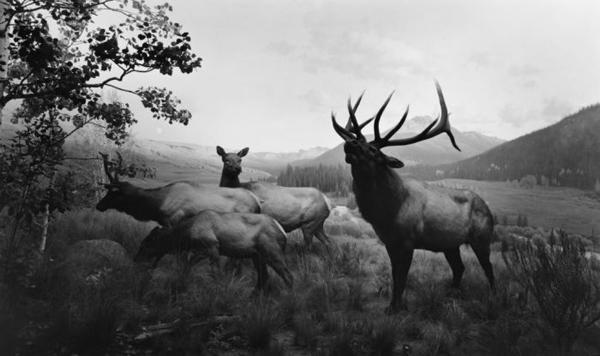Pace Gallery London presents Hiroshi Sugimoto: Still Life, an exhibition of thirteen large-format photographs from the artist’s ongoing Diorama series executed between 1976 and 2012. The artist captures large-scale dioramas inside natural history museums, Sugimoto’s photographs initially seem to be documents of the natural world, featuring far-flung landscapes and wildlife. Sugimoto, however, dwells in the artifice of the images. Composed in crisp black and white and sharp tones, the pristine quality and stillness of these large-scale pieces reveal the inherent artificiality of the constructed worlds that contained within the frames of the works mirroring the vitrines of displays.
Hiroshi Sugimoto (born 1948, Tokyo) studied at St. Paul’s University, Tokyo, and Art Centre College of Design, Pasadena, CA. He has lived and worked in New York since 1974. A conceptual artist who works in many media, Sugimoto was influenced by Minimalism and Conceptual art and has a lifelong connection to the work and philosophy of Marcel Duchamp.
Central to Sugimoto’s work with a camera is the idea that photography is a time machine, a method of preserving and picturing memory and time. This theme provides the defining principle for many of his ongoing series, including Dioramas (1976–present), Theaters (1978–present) and Seascapes (1980–present). He places extraordinary value on the technical aspects of making art. In his photography, Sugimoto prints his work with meticulous attention and a keen understanding of the nuances of silver-print making and its potential for tonal richness in his seemingly infinite palette of blacks, whites, and greys.
The earliest works on view in the exhibition are dated to 1976, when Sugimoto first moved to New York and visited the American Museum of Natural History. “The first time I saw a diorama I was overwhelmed by the fragility of existence that it captured. Being models of nature, dioramas include many of the world’s constituent parts,” Sugimoto wrote. “The only thing absent is life itself. Time comes to a halt and never-ending stillness reigns.” The works both breathe new life into the natural scenes, conjuring a false sense of reality, while highlighting their lifelessness.
Memory and preservation is an essential part of Sugimoto’s oeuvre; evident here in his exploration of nature as expressed through his interest in the museum. Since beginning this series, the notion of fossilisation has become an important concept for Sugimoto and permeates his work. Exploring it as a historical fact and photographic conceit, the fossil serves as a living record and point of departure into history, crystalising a moment in time into a singular object. Sugimoto’s process echoes this notion, capturing these frozen scenes on his large-format camera with specific lighting and extended exposures, lasting as long as twenty minutes.
These pieces synthesise the artist’s lifelong interest in the forces of history with the changes of the natural world and central questions of photography. “All over the planet, nature is being transformed into ‘un-nature’ at breakneck speed,” Sugimoto wrote. “My life is part of natural history. I long to know where that history came from and where it is going.”
The exhibition will be on view at 6 Burlington Gardens until 24 January 2015.

